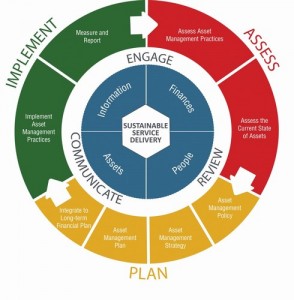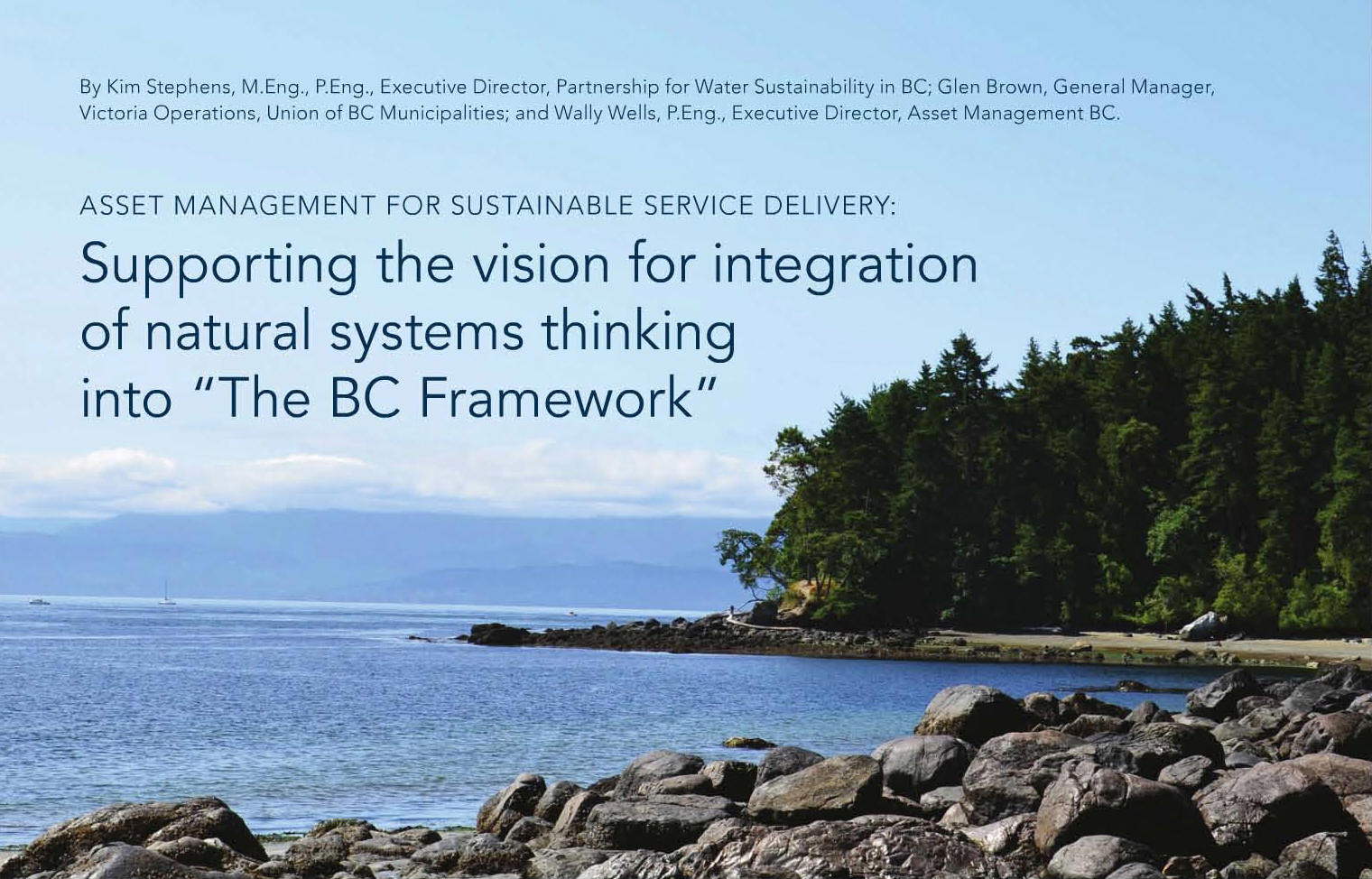Georgia Basin IREI Connects the Dots: Sustainable Watershed Systems & Asset Management
Note to Reader:
Local governments in BC are challenged with the question of how best to move forward with asset management and protection of watershed health in light of two considerations: a changing climate; and community expectations to provide higher levels-of-service at reduced levels-of-cost.
The Summer 2015 issue of Watermark Magazine (published by the BC Water & Waste Association) includes an article that describes how the Partnership for Water Sustainability in BC is championing “asset management for sustainable service delivery”, with a particular emphasis on connecting the dots to a new concept that the Partnership is branding as “Sustainable Watershed Systems, through Asset Management”.
The article is co-authored by Kim Stephens (Partnership Executive Director), Glen Brown (General Manager, Victoria Operations, Union of BC Municipalities) and Wally Wells (Executive Director, Asset Management BC).
Beyond Traditional Municipal Infrastructure
 Released in December 2014, Asset Management for Sustainable Service Delivery: A BC Framework is a game-changer.
Released in December 2014, Asset Management for Sustainable Service Delivery: A BC Framework is a game-changer.
It signifies the dawn of a new era for British Columbia local government in terms of how communities service urbanizing and redeveloping areas, and define how infrastructure is planned, financed, implemented, and maintained.
Natural Systems Thinking
A ‘new business as usual’ is emerging and extends beyond traditional municipal infrastructure to encompass services that nature provides, including hydrologic integrity and watershed health.
This article explains the BC Framework, introduces the ‘asset management continuum’ and foreshadows how the Georgia Basin Inter-Regional Educational Initiative (IREI) will integrate ‘natural systems thinking’ into the BC Framework – to protect watershed health, restore hydrologic integrity and tackle the ‘unfunded infrastructure liability’ that is the unwanted legacy of historical ‘stormwater management.’
Georgia Basin Inter-Regional Education Initiative
Launched in 2012, the IREI provides local governments on the east coast of Vancouver Island with a mechanism to share outcomes and cross-pollinate experience with each other as well as with local governments in the Metro Vancouver region.
The IREI program is developing the technical and educational foundation for implementing land servicing and drainage infrastructure standards of practice that support the Watershed Health Goal (as defined in Beyond the Guidebook 2015: Towards a Watershed Health Legacy in the Georgia Basin, to be released later in 2015).
New Paradigm: Sustainable Watershed Systems, through Asset Management
In March-April 2015, the Boards of five regional districts passed resolutions of commitment to IREI program implementation through 2017. The five regional districts represent 75% of BC’s population.
Starting in 2016, the next phase of the IREI will demonstrate how local governments can progress along the ‘asset management continuum’ to incorporate Sustainable Watershed Systems, through Asset Management.
Point of Departure for the New Paradigm: Asset Management
“The invitation from the BC Water & Waste Association to write an article about the IREI provided us with an early opportunity to initiate the branding of Sustainable Watershed Systems. At the same time, we introduced the concept of an asset management continuum,” explains Kim Stephens. The Partnership functions as the IREI secretariat and Kim Stephens is the program leader.
“ The article actually refers to Sustainable Service Delivery for Watershed Systems. Upon reflection, we realized that it was too much of a leap for practitioners to absorb this concept in one setting. Our Aha was recognizing the need to springboard from the ‘asset management’ term. Hence, within weeks of article publication, we changed the branding to Sustainable Watershed Systems, through Asset Management.”
The article actually refers to Sustainable Service Delivery for Watershed Systems. Upon reflection, we realized that it was too much of a leap for practitioners to absorb this concept in one setting. Our Aha was recognizing the need to springboard from the ‘asset management’ term. Hence, within weeks of article publication, we changed the branding to Sustainable Watershed Systems, through Asset Management.”
“This re-thinking of the approach to informing and educating is consistent with the rationale behind the concept of an ‘asset management continuum’. It is all about understanding the ‘point of departure’ for the target audience – that is, where is their thinking currently at. If a local government is only just getting into asset management per se, then it would be premature to use language that talks in terms of sustainable service delivery. Put another way, one has to learn to walk before one learns to run,” concludes Kim Stephens.
To Learn More:
To download and read the complete article, click on Asset Management for Sustainable Service Delivery: Supporting the Vision for Integration of Natural Systems Thinking into “The BC Framework”
Natural Services & Asset Management Continuum
“Asset management is a continuous process, not a discrete task. Too much emphasis is too often placed on the ‘Asset Management Plan.’ The PLAN is only a part of the overall process,” explains Wally Wells, Executive Director of Asset Management BC.
“ The PROCESS deals with all of the components necessary to refocus the business process to achieve three desired outcomes. First, properly manage a community’s infrastructure within the built environment. Secondly, understand the life-cycle implications of managing the built and natural environments as integrated components of a healthy watershed. Thirdly, inform and educate elected representatives and citizens.”
The PROCESS deals with all of the components necessary to refocus the business process to achieve three desired outcomes. First, properly manage a community’s infrastructure within the built environment. Secondly, understand the life-cycle implications of managing the built and natural environments as integrated components of a healthy watershed. Thirdly, inform and educate elected representatives and citizens.”
“The asset management process is a continuum. The process starts with the engineered assets that local governments provide. Communities will progress along the continuum incrementally as their understanding grows. By also accounting for and integrating the services that nature provides, over time they can achieve the goal of Sustainable Service Delivery for watershed systems.”



